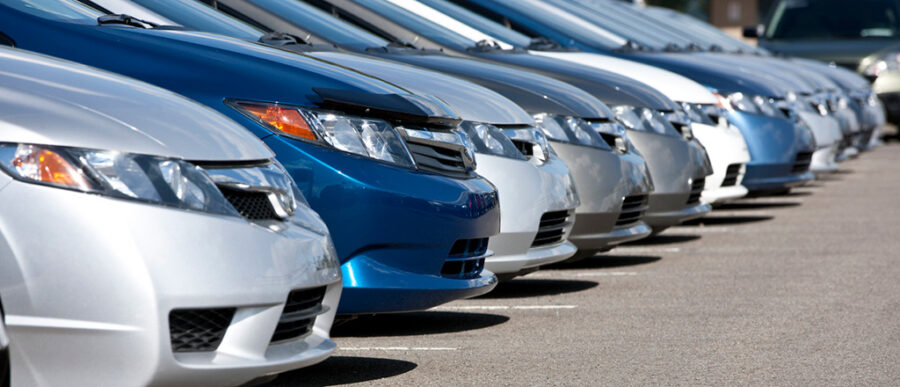While sales of products like toilet paper, hand sanitizer even home appliances have skyrocketed during the coronavirus pandemic, auto sales have experienced the opposite. Through March, April and May, total vehicle sales in the United States fell to levels not seen since the Great Recession a decade ago. Demand crashed as millions of commuters suddenly found themselves working from home or laid off, and consumers responded predictably to the economic uncertainty by putting off expensive purchases such as new cars, trucks and SUVs.
But with the lockdowns gradually lifting across all 50 states and life returning to a more normal pace, auto dealers are feeling cautiously optimistic that sales will pick up again and increase throughout the summer months. The bigger question is whether the rest of the year can make up for the springtime slide.
“It’s definitely going to be one of those years that’s remembered as unique and uniquely disruptive and posing all kinds of crazy challenges,” Wharton management professor John Paul MacDuffie said. “If you look around the world, it’s going to be a story of different countries and different companies taking bigger hits at different times than others, recovering more easily or having more difficulty for a variety of reasons.”
MacDuffie, who is also director of the Program on Vehicle and Mobility Innovation at Wharton’s Mack Institute for Innovation Management, spoke about post-pandemic auto sales during a segment on the Wharton Business Daily radio show on Sirius XM. (Listen to the podcast at the top of this page.)
It’s not only the downturn in sales that is hurting the industry, he said. Automakers are also dealing with a number of challenges caused by the pandemic, including shoppers who are reluctant to venture into showrooms, disruptions in the manufacturing supply chain that are just beginning to resolve, and the need to reconfigure factories to allow social distancing for workers.
“There is relatively high demand for certain types of products, particularly trucks and SUVs,” MacDuffie said. “Pretty much every assembly plant in the U.S. now is open and starting to slowly ramp up. Some of those plants are having some supply chain problems, particularly from Mexico, which is still in an intense stage of coping with the virus. But, for the most part, they’ve had time to deal with finding alternate sources or helping out with that, so production is not all that interrupted. The slow ramp up means there’s time to figure out the safety aspects of working in the factories.”
“I think some of the worst fears, perhaps, from the depths of March and April have maybe not been realized.” –John Paul MacDuffie
His thoughts about the industry are echoed in a survey of more than 1,000 auto dealers conducted by Cox Automotive. The survey, released June 8, found both concern and optimism about the 2020 outlook. Dealers had a “negative” overall view of the market for the second quarter, but some segments also cited pent-up demand and the possibility of a quick economic recovery as reasons to be hopeful.
“The COVID-19 pandemic dramatically impacted the market, so it is no surprise to see views of sales, profits and sentiment significantly down in the second quarter survey,” Cox Automotive chief economist Jonathan Smoke said in a statement. “However, what stands out the most to me is the optimism of franchised dealers about the next 90 days. The majority of franchises are optimistic about the rest of the spring and summer despite the weak economy, weak current sales and declining inventory.”
The Numbers Tell the Story
The seasonally adjusted annual rate (SAAR) for vehicles sold in the U.S. in February was about 17 million, according to federal data. (SAAR is an annual estimate based on a given month’s sales.) The figure is comparable to the same month last year. But March, April and May tell a different story. The March 2020 SAAR was 11.7 million, compared with 17.7 million in March 2019; and 9 million in April 2020, compared with 17 million in April 2019.
The May 2020 SAAR increased to 12.5 million vehicles — compared with 17.9 million in May 2019 — perhaps an indication the industry is starting to rebound. MacDuffie partly credited the uptick to buyer incentives such as zero-percent financing.
“So, 17 million cars a year has been roughly the pace of sales in the U.S. in the last few years. This year it will probably come in no better than 13 or 14, so it’s still a very bad year by most accounts,” he said. “There’s not really going to be a V-shaped recovery in terms of sales, but much more gradual. Much more gradual suits the needs for the supply chain to be able to get back into shape for reliable delivery of parts and also to make the factories safe.”
MacDuffie also said some factories are reopening with reduced shifts, which will affect the production rate if there is a surge in demand.
“There [are] lots and lots of ways that the industry is having to cope with this,” he said. “But I think some of the worst fears, perhaps, from the depths of March and April have maybe not been realized.”
Another uncertainty is how the pandemic will shift consumer preferences. Before the pandemic, light trucks and SUVs were trending, and automakers were responding with strong product lineups for that segment. It’s hard to say whether that trend will last now. And there is also the possibility that urban dwellers will abandon public transportation and ridesharing options out of fear of viral spread, getting back into their own vehicles instead.
“More work from home will reduce one piece of it. But there’s definitely potential for massive congestion problems if everybody starts just coming back in their own car and trying to drive,” he said. “But it’s pretty good for sales, you might say.”
“There’s not really going to be a V-shaped recovery in terms of sales, but much more gradual.” –John Paul MacDuffie
Technology and Tesla
Even if drivers prefer their own vehicles to shared mobility, MacDuffie doesn’t think that traditional automakers will stop investing in new technologies, including self-driving, hybrid and electric cars.
“Electric cars have been on the verge of a tipping point,” he said. “They have been disappointing, but the technology keeps getting better, the battery costs keep getting cheaper, the range keeps getting higher. And many of the traditional auto companies have made really big commitments now over periods of years to bring out a lot of these new electric vehicles to compete at the high end with Tesla and to provide them through their whole range.”
He doesn’t see automakers backing away from that commitment, even as the federal government has rolled back mileage and emissions standards, creating a disincentive to go forward with electric vehicles.
“But the industry is saying, ‘You know, this is the path we’re on. It’s the right thing to do. We have all these sunk costs already. We’re going to go forward with it,’” MacDuffie said.
Tesla is one of the leaders in pushing the technology forward. Buoyed by their historic SpaceX launch on May 30 and a new factory in Shanghai that is reportedly building 3,000 cars a week, the company is seeing its stock soar. Tesla stock recently passed the $900 mark, thanks to robust sales of its cars in China.
“Even before the successful SpaceX launch, this has been a period when Tesla is, once again, a darling of investors. The believers are having way more success than the skeptics that are shorting the stock,” MacDuffie said.
He thinks Musk, who is working to open a second factory in the U.S. and one in Europe, will easily secure funding for his expansion.
“They’re not having any trouble getting investment capital for this. They continue to build out their retail network. They don’t do much advertising,” he said. “The stock performance and the general buzz about Tesla and Elon Musk have been really very positive for quite a while, and the SpaceX [launch] is only going to accentuate that.”



